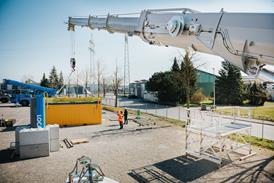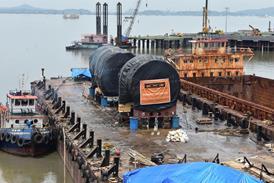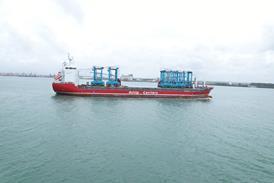December 7 - With its LR 13000, which is currently being tested at Liebherr-Werk Ehingen GmbH, Liebherr is extending the range of crawler cranes.
The new flagship unit, with a maximum lifting capacity of 3,000 tonnes at 12 m outreach, ushers in a whole new dimension in size for crawler cranes of conventional design.
The most important area of operations for the new LR 13000 (seen below) is going to be the power station construction sector says Liebherr, adding that for the latest generation of nuclear power plants in particular, the lifting of extremely heavy unit items is essential. Added to this is the fact that pre-assembled modules increasingly require lifting as complete units, which again drives the unit weights upwards. In refineries, too, there is a growing demand for industrial columns to be set up which weigh 1,500 tonnes and reach 100 m in length. Ever larger cranes are also needed for the preliminary assembly of offshore steel structures such as oil platforms.
The new LR 13000 crawler crane provides a maximum system length of 246 m, which is achieved via the configuration of a 120 m main boom and 126 m luffing fly jib, resulting in a maximum hook height of 240 m. A new boom system provides extreme flexibility, with the main boom and the luffing jib allowing for four different boom systems to be combined - light, medium heavy, heavy, and super-heavy, depending on the operational requirements, says Liebherr.
The company claims that its new LR 13000 is the only crawler crane in this size class which can work without derrick ballast. This is achieved by an extremely powerful slewing ring, developed and manufactured by Liebherr itself. This slewing ring is capable of transferring high torque, by contrast with the solutions from other manufacturers with ringer systems on the crawler travel gear. In order to achieve the best possible lifting capacities without derrick ballast, the standard slew superstructure ballast is raised from 400 tonne to 750 tonne. This means that the crane can be used universally in the part-load range when the maximum lifting capacities are not called for on a particular site, and it also makes handling a great deal easier.
A suspended ballast system is provided on the 54-metre long derrick boom, which can be adjusted over the derrick boom without a guide, steplessly from 20 m to 30 m ballast radius. This arrangement has already proved its value on the 1,350 tonne lift capacity LR 11350.
As an alternative, Liebherr can offer a new concept in ballast trailer systems for the LR 13000, for which the standard suspended ballast arrangement is combined with heavy lift module trailers (SPMT).
The enormous size and capacity of the new 3,000 tonne model poses many challenges for transport logistics and Liebherr has made sure that no single component weighs more than 70 tonnes. Most of the components are transported with a height of 3.6 m and 4 m in width. The track, weighing 82 tonnes, is taken off, and when dismantled can be economically transported in containers. The track carrier weighing 128 tonnes is divided in half, and travels on two low-loaders. The slewing ring, 4.5 m wide, is transported in a diagonal position, in order not to exceed a width of 4 m. The ballast slabs, weighing 25 tonnes, are made of reinforced concrete for reasons of costs. They have the exact dimensions of a 20 ft container and can be loaded with a spreader.
When it came to the boom design, economical transport logistics were again a key issue and for transport, the intermediate elements of the luffing fly jib are pushed into the intermediate elements of the main boom with the aid of rollers.
The crane's cables have some impressive dimensions too. 52 mm thick, a total length on each hoisting winch of about 2,000 m, and a line pull of 62 tonne. To guarantee maximum operational reliability and ensure easy maintenance, all the winches are driven by several independent motors on an internal gearing of the cable drum. This means that the crane can continue working even if a drive unit breaks down, and the unit can be replaced rapidly and easily.
The hook block weighs 111 tonnes and is 9.7 m high, for lifting up to 3,000 tonnes. It is of modular design and consists of a maximum of two hooks and six pulley sets, with five pulleys each. It can be configured easily for different operational purposes.















